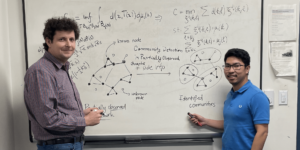
USC Viterbi’s Dina El-Damak, WiSE Gabilan Assistant Professor in the Ming Hsieh Department of Electrical Engineering (Photo/Michelle Henry)
Almost everyone in the world has heard of the process of photosynthesis, even if they haven’t thought about it since high school biology.
Though the entire process itself is extremely complicated and involves words like “the Calvin cycle” and “enzyme RuBisCO,” when looked at in the most basic sense, photosynthesis is the process of converting light energy from the sun into chemical energy and sugar: these by-products are then used to nourish and sustain the plant.
In simpler terms, a plant takes energy from its surrounding environment and converts it into a different form of energy that is then used to keep the plant alive and functioning.
This process is similar to what USC Viterbi’s Dina El-Damak is doing with batteries.
El-Damak, a WiSE Gabilan Assistant Professor in the Ming Hsieh Department of Electrical Engineering, is an integrated circuit and system designer. Her research focuses on the design of low-power circuits to allow other low-power devices to operate completely battery-free, or with the smallest possible amount of energy input required. The ultimate goal is to extend the lifetime of the devices in question, affecting devices ranging in function from complex gastric acid batteries to the light bulbs found in our homes.
To do this, she focuses specifically on the design of integrated circuits that interface with different energy harvesters to look for available energy in the surrounding environment. Simply put, she creates batteries that don’t need to be plugged in to charge and function.
“The operation time of a device in general is currently dictated by the battery’s size that it can support,” El-Damak said. “Looking into opportunities to harvest energy from the environment will help us minimize the electronic devices’ size and extend the operation time.”
This type of research has especially important biomedical applications. One such example is electronic pill powered by the gastric acid battery. This battery can withstand the stomach’s harsh, acidic environment and has several potential applications: two of the most important are long-term drug delivery release – achieved by having the pill expand once inside the stomach and remain there for an extended period of time – and overall monitoring of the patient’s well-being.
“The GI tract is an interesting environment to monitor many vital signals inside the body but figuring out how to get a pill to operate for an extended period of time once it is inside the stomach has been a challenge in the past,” El-Damak said.
This battery is idle prior to being swallowed. However, once it reaches the patient’s stomach, it begins operating, using stomach acid as the electrolyte of the battery.
“Batteries such as these are biocompatible with the human body, which means that they are not dangerous when ingested,” El-Damak said. “They have many applications in addition to transmitting information, such as long-term drug delivery release.”
Though the creation of integrated and low-power circuits is her main field of research, El-Damak is also an avid researcher on the “internet of things.” Her work in this arena focuses on biomedical applications and power management.
The “internet of things” is an expression currently used to describe the eventual reality of complete interconnectedness that our world is hypothesized to achieve. This will be accomplished through the implantation of sensors in all devices, including the human body, all relaying their information back to various sources to improve decision making and lives overall.
Though not a completely accurate representation, to picture the implantation of sensors in humans and what that might mean, consider the season one “Black Mirror” episode, “The Entire History of You.” In it, everyone on earth is revealed to have a sensor implanted behind their ear that enables them to record their entire lives, as well as replay their memories at will.
One such example of where El-Damak’s work fits into this picture is a project she conducted a few years ago on the detection of seizures before they occur. She was part of a team, led by MIT‘s Anantha Chandrakasan and the National University of Singapore‘s Jerald Yoo, who designed an EEG acquisition system on a chip that recorded brain waves in an effort to identify telltale waves signifying when a person will have a seizure.
If seizure suppression stations are implanted in the subject’s body, they will need to function long-term to suppress seizures as intended, especially for someone who has a condition such as epilepsy, where seizures are an unpredictable but chronic occurrence.
“Wearable and implantable devices eventually have to have their batteries replaced, which is a hassle,” El-Damak said. “If all these devices could run battery-free that would have a great impact on the user.”
Published on April 10th, 2018
Last updated on January 2nd, 2021










